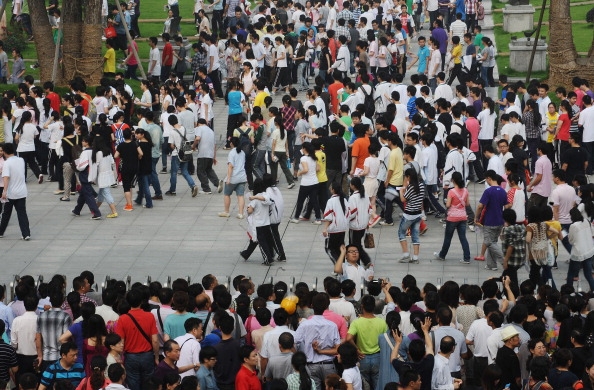You have /5 articles left.
Sign up for a free account or log in.

Students in China arrive for the exam.
AFP / Getty Images
Chinese applicants to the University of San Francisco need not submit a transcript or an SAT score under a newly announced pilot program. Rather, the private Jesuit institution plans to admit students based on their scores on the grueling, multiday Chinese university entrance exam, the gaokao, and their performance in an in-person interview in Beijing.
Students admitted through this pathway will not be required to submit standardized English language test results, although USF plans to administer its own English language test during the interview, according to Stanley D. Nel, the university’s vice president for international relations.
Nel said his goal is not to flood the University of San Francisco with additional Chinese students -- USF enrolled more than 1,000 students from China last fall, including 846 undergraduates -- but rather to identify 5 to 10 top students who do well on the gaokao but not well enough to get into the Chinese university of their choice (the gaokao is far more central to admissions decisions in China than the SAT or ACT generally is in the U.S.).
Every year, some students who fall short of their hoped-for gaokao score change direction and choose to apply to American universities, a decision that generally means they need to take an extra year to prepare for the SAT and standardized English language tests and otherwise complete the typical American university admissions process. USF wants to save these students the trouble -- and the time -- by admitting them for the coming fall on the basis of an interview and a test they’ve already taken.
“Our hope is in this way we can get at the very top students in China,” said Nel.
He anticipates that USF will set gaokao cutoff scores equivalent to the marks needed to get into a first-tier Chinese university in each province, plus or minus a few points. Students who are admitted based on their gaokao scores will pay their own way, though Nel said they could be eligible for merit scholarships of up to $20,000 per year.
The gaokao, which is administered by each individual province -- and which is undergoing major revisions over the next few years -- includes mandatory sections in mathematics, Chinese and a foreign language (typically English), as well as either humanities or science components depending on the student's chosen academic track.
A number of Australian universities -- including the University of Sydney -- accept gaokao scores for undergraduate admissions, and the test, for all its limitations (more on this below) could represent a relatively reliable source of information for admissions officers who are struggling with the problem of fraud in Chinese student applications. But the timing of the gaokao is tricky as it relates to a standard American university admission cycle: the students USF wants to have on its campus this fall won’t take the gaokao until June. Nel said the earliest students could reasonably be admitted through this program is the third week in July, leaving them just about a month to apply for a student visa and travel to USF’s campus before classes start on Aug. 25.
For that reason, Terry Crawford, the co-founder of InitialView, a company that does video interviews for Chinese applicants to American universities, said he thinks it’s unlikely that USF’s approach will be widely adopted. “I don’t think it can work on a wide scale with the way admissions works in the U.S., just because there’s a season for that and that season is not going to change. Selective schools want to get the students squared away May 1.”
At the same time, Crawford said that USF “should deserve some credit for trying something new here” and that the decision to rely on the gaokao may be a way to circumvent some of the issues surrounding fraud. “I don’t think transcripts are dependable in China, essays and teacher recs, those aren’t dependable, but I think a gaokao score is.”
A challenge, Crawford said, is that students who have been planning to go to a U.S. university all along -- and have the financial means and English language skills to do so -- typically forgo the gaokao. And while InitialView interviews many students who change course and decide to apply to American universities after struggling on the gaokao, Crawford said those students’ English language skills tend to be “on the low end of the spectrum of students we interview.”
“Their biggest challenges don’t include finding students with good gaokao scores,” Michael Gow, a global postdoctoral fellow at New York University’s Shanghai campus who studies Chinese higher education, said via email. “That is relatively straightforward. Their biggest challenges are (1) finding academically excellent students willing to turn down top Chinese universities for USF and (b) finding students whose English is of a high enough standard to go straight into [undergraduate] study without extensive English classes beforehand. They do exist.”
Gow cautioned, however, that a tier 1 score on the gaokao is not in itself an indicator of “top-class quality.” Gow noted that the proportion of tier 1 scores earned varies by province as a function of the population of test takers and the number of top university places allotted, with the ultimate result that students from some areas -- notably Beijing and Shanghai -- are much more likely to achieve tier 1 gaokao scores than students from other parts of China. (How much more likely? Gow cited unofficial statistics showing that nearly a quarter of test takers in Beijing earned tier 1 scores last year against a national average of around 11 percent).
“So simply accepting tier 1 is not a reliable indicator of top-class quality,” Gow said. “But when you add the English interview, assessment, then the tier 1 [score] becomes a reliable indicator on academic consistency and commitment. It’s a brutal exam. Any kid getting through it with tier 1 deserves some credit. The English interviews are a great way to complement and assess students' critical thinking, dispositions, attitudes and personality.”
Nel, of USF, said the university would ideally like to correct for the geographical bias built into the gaokao system by adjusting the university’s own cut scores by province accordingly, but said he doesn’t know whether he will have access to the data necessary to make those kinds of adjustments. “No doubt this test has its own flaws,” Nel said -- he noted as another example the emphasis on rote memorization -- but he thinks it’s worth trying out as an alternative to asking students to spend a gap year doing SAT and English language test preparation. And he emphasized that with the interview requirement, a good gaokao score will be “necessary but not sufficient” for students to get into USF.
“If this is what Chinese students prepare for, let's see where we can use this test,” Nel said.
“The question is, how do you identify the Chinese students who are in some sense good as measured by their own system?”








